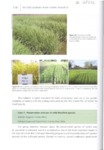Use este identificador para citar ou linkar para este item:
http://www.alice.cnptia.embrapa.br/alice/handle/doc/933998Registro completo de metadados
| Campo DC | Valor | Idioma |
|---|---|---|
| dc.contributor.author | ALVES, A. A. C. | pt_BR |
| dc.date.accessioned | 2012-09-18T11:11:11Z | pt_BR |
| dc.date.available | 2012-09-18T11:11:11Z | pt_BR |
| dc.date.created | 2012-09-18 | pt_BR |
| dc.date.issued | 2009 | pt_BR |
| dc.identifier.citation | In: MARIANTE, A. da S.; SAMPAIO, M. J. A.; INGLIS, M. C. V. (Ed.). The State of Brazil´s plant genetic resources : second national report : conservation and sustainable utilization for food and agriculture. Brasília, DF : Embrapa Technological Information, 2009. p. 114-115 il. | pt_BR |
| dc.identifier.uri | http://www.alice.cnptia.embrapa.br/alice/handle/doc/933998 | pt_BR |
| dc.description | The genus Manihot includes about 98 documented species of which only M. esculenta is cultivated, and it is considered as one of the most important staples in the tropical human diet. Embrapa's breeding program is working exclusively with genetic diversity of this cultivated species. Despite its rusticity, cassava undergoes great losses due to biotic and abiotic factors. Wild species, which contain resistance genes to main stresses affecting this crop, are very seldom studied and many of them are endangered. Brazil, considered the main center of origin of cassava, holds the largest global genetic diversity of Manihot, disseminated ali over the country. One of the main objectives of Embrapa Cassava and Tropical Fruits has been the establishment and broadening of one collection of this valuable germplasm so as to make the utilization of useful genes from wild species possible. Over the last 4 years, one collection was established with accessions obtained from different sources, including harvesting carried out in the Semi-Arid (Caatinga) and Cerrado (Federal District and environs) regions. Currently, this collection holds about 920 accessions (with at least 18 wild species), displays broad vegetative polymorphism and has a potential for utilization in cassava genetic breeding programs (Figure 20). One sexual seed bank is also being preserved that holds approximately 60,000 seeds (open pollination). | pt_BR |
| dc.language.iso | eng | eng |
| dc.rights | openAccess | eng |
| dc.title | Preservation and use of wild Manihot species. | pt_BR |
| dc.type | Parte de livro | pt_BR |
| dc.date.updated | 2017-08-04T11:11:11Z | pt_BR |
| dc.subject.nalthesaurus | Manihot | pt_BR |
| dc.subject.nalthesaurus | breeding | pt_BR |
| riaa.ainfo.id | 933998 | pt_BR |
| riaa.ainfo.lastupdate | 2017-08-04 | pt_BR |
| dc.contributor.institution | ALFREDO AUGUSTO CUNHA ALVES, SRI. | pt_BR |
| Aparece nas coleções: | Capítulo em livro científico (CNPMF)  | |
Arquivos associados a este item:
| Arquivo | Descrição | Tamanho | Formato | |
|---|---|---|---|---|
| PreservationanduseofwildManihotspecies.00011.pdf | 882.77 kB | Adobe PDF |  Visualizar/Abrir |









